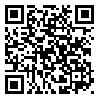Volume 13, Issue 1 (2021)
JHS 2021, 13(1): 163-194 |
Back to browse issues page
Download citation:
BibTeX | RIS | EndNote | Medlars | ProCite | Reference Manager | RefWorks
Send citation to:



BibTeX | RIS | EndNote | Medlars | ProCite | Reference Manager | RefWorks
Send citation to:
shahedi M. The proportion of the freedom movement of Iran with pluralism and political tolerance; from the victory of the revolution until the adoption of the constitution of the Islamic republic of Iran (February - December 1979). JHS 2021; 13 (1) :163-194
URL: http://jhs.modares.ac.ir/article-25-44444-en.html
URL: http://jhs.modares.ac.ir/article-25-44444-en.html
Senior Researcher at the Contemporary History Research Institute , mozaffarshahedi@gmail.com
Abstract: (2623 Views)
Although in the process of the expansion and victory of the Iranian Revolution, in the years 1356- 1357, the Islamic movement played a decisive role; However, the Iranian Revolution also had the presence and effective participation of left-wing parties and political groups, liberal nationalists, and some groups with Islamist, left-wing, and nationalist aspirations. The Iranian Freedom Movement, which was closely associated with the Islamist movement, played an important role in the developments of the revolutionary period.
Purpose of the research: Considering that Imam Khomeini, the leader of the revolution, recognized pluralism and party politics within the framework of the Islamic Republic; The leading article attempts to answer the following question: From the beginning of the victory of the revolution until the endorsement and final approval of the constitution in December 1358, which established the legal-legal framework of the Islamic Republic, What did the Iranian Freedom Movement approach to pluralism, political commitment and loyalty among parties and political parties in the revolutionary party?
Purpose of the research: Considering that Imam Khomeini, the leader of the revolution, recognized pluralism and party politics within the framework of the Islamic Republic; The leading article attempts to answer the following question: From the beginning of the victory of the revolution until the endorsement and final approval of the constitution in December 1358, which established the legal-legal framework of the Islamic Republic, What did the Iranian Freedom Movement approach to pluralism, political commitment and loyalty among parties and political parties in the revolutionary party?
Research method: The present study is conducted through a historical survey (descriptive-analytical) and using a process tracking technique.
The research findings show that Iranian's Freedom Movement, whose political orientation and intellectual foundations were a combination of Islam and liberal nationalism, despite criticisms of the tendencies and practices of various political currents, He called for political engagement and loyalty among revolutionary parties and groups. The Iranian Freedom Movement supported the pluralism, supremacy, and peaceful party politics within the framework of the Islamic Republic.
Send email to the article author
| Rights and permissions | |
 |
This work is licensed under a Creative Commons Attribution-NonCommercial 4.0 International License. |








